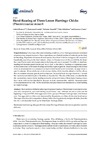Identificador persistente para citar o vincular este elemento:
https://accedacris.ulpgc.es/handle/10553/73935
| Campo DC | Valor | idioma |
|---|---|---|
| dc.contributor.author | Fiorucci, Letizia | en_US |
| dc.contributor.author | Grande, Francesco | en_US |
| dc.contributor.author | Macrelli, Roberto | en_US |
| dc.contributor.author | Schnitzer, Petra | en_US |
| dc.contributor.author | Crosta, Lorenzo | en_US |
| dc.date.accessioned | 2020-08-03T10:34:24Z | - |
| dc.date.available | 2020-08-03T10:34:24Z | - |
| dc.date.issued | 2020 | en_US |
| dc.identifier.issn | 2076-2615 | en_US |
| dc.identifier.other | Scopus | - |
| dc.identifier.uri | https://accedacris.ulpgc.es/handle/10553/73935 | - |
| dc.description.abstract | There are few published studies regarding lesser flamingo (Phoeniconaias minor) reproduction, crop milk composition, and hand-rearing under human care. Between the end of June and the beginning of August of 2017, three eggs were laid in a group of 29 lesser flamingos kept under human care. Two eggs and one chick were abandoned by the parents, and three chicks were handreared. This report describes diet composition, dietary intake, feeding protocols, and growth index, from the first day to 60 days after hatching, for three lesser flamingo chicks. | en_US |
| dc.language | eng | en_US |
| dc.relation.ispartof | Animals | en_US |
| dc.source | Animals [EISSN 2076-2615], v. 10 (8), 1251, (Agosto 2020) | en_US |
| dc.subject | 310907 Patología | en_US |
| dc.subject | 3105 Peces y fauna silvestre | en_US |
| dc.subject.other | Diet | en_US |
| dc.subject.other | Growth Index | en_US |
| dc.subject.other | Hand-Rearing | en_US |
| dc.subject.other | Lesser Flamingo (Phoeniconaias Minor) | en_US |
| dc.subject.other | Spirulina (Spirulina Platensis) | en_US |
| dc.title | Hand-rearing of three lesser flamingo chicks (Phoeniconaias minor) | en_US |
| dc.type | info:eu-repo/semantics/Article | en_US |
| dc.type | Article | en_US |
| dc.identifier.doi | 10.3390/ani10081251 | en_US |
| dc.identifier.scopus | 85088572010 | - |
| dc.contributor.authorscopusid | 57103294400 | - |
| dc.contributor.authorscopusid | 57103030500 | - |
| dc.contributor.authorscopusid | 57103699700 | - |
| dc.contributor.authorscopusid | 57218282908 | - |
| dc.contributor.authorscopusid | 6602582801 | - |
| dc.identifier.eissn | 2076-2615 | - |
| dc.description.lastpage | 7 | en_US |
| dc.identifier.issue | 8 | - |
| dc.description.firstpage | 1 | en_US |
| dc.relation.volume | 10 | en_US |
| dc.investigacion | Ciencias de la Salud | en_US |
| dc.type2 | Artículo | en_US |
| dc.description.notas | This article belongs to the Special Issue The Animal–Human Interfaces in Physiology of Reproduction: The Research to Improve Performance, as well as Animal and Human Health | en_US |
| dc.utils.revision | Sí | en_US |
| dc.date.coverdate | Agosto 2020 | en_US |
| dc.identifier.ulpgc | Sí | es |
| dc.description.sjr | 0,584 | |
| dc.description.jcr | 2,752 | |
| dc.description.sjrq | Q1 | |
| dc.description.jcrq | Q1 | |
| dc.description.scie | SCIE | |
| item.fulltext | Con texto completo | - |
| item.grantfulltext | open | - |
| Colección: | Artículos | |
Citas SCOPUSTM
2
actualizado el 08-jun-2025
Citas de WEB OF SCIENCETM
Citations
2
actualizado el 08-jun-2025
Visitas
117
actualizado el 18-may-2024
Descargas
100
actualizado el 18-may-2024
Google ScholarTM
Verifica
Altmetric
Comparte
Exporta metadatos
Los elementos en ULPGC accedaCRIS están protegidos por derechos de autor con todos los derechos reservados, a menos que se indique lo contrario.
